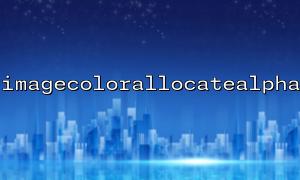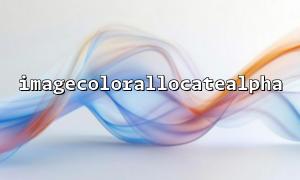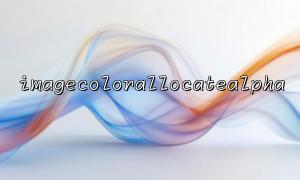Dynamically generating colors and images is a very common requirement in web development. PHP provides some built-in image processing functions, where imagecolorallocatealpha is a very useful function that can help us generate colors with transparency (RGBA). This article will introduce how to use this function to dynamically generate RGBA color boards.
First of all, PHP image processing is mainly implemented through the GD library. The GD library allows us to create images, edit images, and process various pixels in the image. The imagecolorallocatealpha function is a member of the GD library, which allows us to assign a color to the image and can set the transparency of the color (alpha value).
The basic syntax of the imagecolorallocatealpha function is as follows:
imagecolorallocatealpha(resource $image, int $red, int $green, int $blue, int $alpha): int
$image : Image resource.
$red , $green , $blue : The RGB value of the color, ranging from 0 to 255.
$alpha : Transparency value, ranging from 0 (completely opaque) to 127 (completely transparent).
The return value of the function is a color identifier that can be used to draw a graph in an image.
Suppose we need to dynamically generate an RGBA color board to display different colors and their transparency. Here is a simple example showing how to dynamically generate RGBA color boards using the imagecolorallocatealpha function:
<?php
// Create a 256x256 Blank image
$image = imagecreatetruecolor(256, 256);
// To support transparency,We need to set up alpha aisle
imagesavealpha($image, true);
// Traversal generation RGBA Color board
for ($r = 0; $r < 256; $r += 32) {
for ($g = 0; $g < 256; $g += 32) {
for ($b = 0; $b < 256; $b += 32) {
// Randomly set transparency
$alpha = rand(0, 127);
// Assign colors,Pay attention to transparency values
$color = imagecolorallocatealpha($image, $r, $g, $b, $alpha);
// Draw rectangular blocks to represent color
imagefilledrectangle($image, $r, $g, $r + 31, $g + 31, $color);
}
}
}
// Output image to browser
header('Content-Type: image/png');
imagepng($image);
// Clean the memory
imagedestroy($image);
?>
We first created a 256x256 image and set up imagesavealpha to enable transparent channels.
Using a three-layer for loop, we generate different combinations of RGB values and assign colors with transparency through the imagecolorallocatealpha function.
The imagefilledrectangle function is used to draw rectangle blocks on an image, each rectangle represents a color.
Finally, we output the image to the browser through the header function.
Through the above code, we can see a 256x256 color board in the browser, each small piece showing different RGB combinations and transparency. Because of the use of the imagecolorallocatealpha function, we can add different transparency to each color, so that the color board not only displays the color, but also displays changes in transparency.
When generating color boards, you may also need to use the URL address as part of the image. For example, you can use the following code to load an image from an external URL and combine it with a color board:
<?php
// Loading remote pictures
$imageUrl = 'http://m66.net/path/to/your/image.png';
$image = imagecreatefrompng($imageUrl);
// Set image size
$width = imagesx($image);
$height = imagesy($image);
// Output image
header('Content-Type: image/png');
imagepng($image);
// Free up resources
imagedestroy($image);
?>
Through the imagecreatefrommpng function, we can load PNG images of external URLs.
Use imagepng to output images to the browser.
In this way, we can display remote images on the color board and set different transparency for them.















